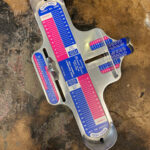Need to use the euro symbol (€) on your Windows PC or Mac? Whether you’re writing emails, creating documents, or managing your finances, knowing how to quickly insert the euro sign is essential. This guide provides you with all the methods you need to easily type the euro symbol using your PC keyboard, along with helpful tips for mobile devices and word processors.
Understanding the Euro Symbol
The euro sign, €, is the currency symbol for the Eurozone, representing the single European currency. Inspired by the Greek letter epsilon (Є) and the first letter of ‘Europe’, the symbol was officially adopted in 1995. The two parallel lines across the ‘C’ are said to represent stability in the euro currency.
While you might primarily see prices displayed with the euro sign before the amount (e.g., €10), understanding how to create this symbol on your computer is key for clear communication and accurate representation of euro currency in your digital documents.
Typing the Euro Sign on Windows PC Keyboards
For Windows users, the quickest way to type the euro sign is through a simple keyboard shortcut:
Using CTRL + ALT + 4:
- Press and hold down the CTRL key and the ALT key simultaneously.
- While holding these keys, press the number 4 key located on the top row of your keyboard.
Instantly, the euro symbol (€) will appear in your document or text field. This shortcut works across various applications on Windows, from word processors to web browsers.
Alternative Method: Using the Numeric Keypad (Alt Codes)
If the above shortcut doesn’t work or you prefer using Alt codes, you can use the numeric keypad on the right side of your keyboard (if you have a full-sized keyboard):
- Ensure Num Lock is activated.
- Press and hold down the ALT key.
- While holding ALT, type the number 0128 on the numeric keypad.
- Release the ALT key.
The euro symbol (€) should appear. This method is a universal way to insert various symbols on Windows, including the euro sign.
Typing the Euro Sign on Mac Keyboards
Mac users also have a straightforward keyboard shortcut to access the euro symbol:
Using Option + 2:
-
Press and hold down the Option key (sometimes labeled as “Alt”).
-
While holding Option, press the number 2 key.
The euro symbol (€) will be inserted. For some US Mac keyboards, you might need to use Shift + Option + 2. Try both combinations to find the one that works for your keyboard layout.
Inserting the Euro Sign on Mobile Devices (iOS and Android)
Typing the euro sign on your smartphone or tablet is also simple:
For iOS and Android:
- Open your device’s keyboard in any text field.
- Switch to the numbers and symbols keyboard (usually by tapping a button labeled “123” or “&%#”).
- Look for the € symbol. It is often readily available on this keyboard layout.
- If you don’t see it immediately, try long-pressing the dollar ($) sign. This often reveals a pop-up menu with related currency symbols, including the euro sign.
- Tap the € symbol to insert it.
Using Word Processors to Insert the Euro Sign
Both Microsoft Word and Google Docs provide easy ways to insert symbols like the euro sign through their menus:
Microsoft Word:
- Click on the Insert tab in the top menu.
- On the far right side, find and click on Symbol.
- Select Symbol again from the dropdown menu.
- In the Symbol dialog box, you should find the euro symbol in the commonly used symbols or you can search for it. Select the € symbol and click Insert.
Google Docs:
- Click on Insert in the top menu.
- Select Special characters.
- In the Special characters dialog, type “euro” in the search bar.
- The euro symbol will appear. Click on it to insert it into your document.
Conclusion
Typing the euro sign on your PC keyboard, whether you’re using Windows or Mac, is a quick and easy process once you know the shortcuts. From simple keyboard combinations to mobile device options and word processor menus, you have multiple ways to access this important currency symbol. Mastering these methods will ensure you can accurately and efficiently use the euro sign in all your digital communications and documents.


